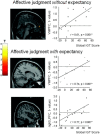Affective judgment and beneficial decision making: ventromedial prefrontal activity correlates with performance in the Iowa Gambling Task
- PMID: 16372256
- PMCID: PMC6871437
- DOI: 10.1002/hbm.20202
Affective judgment and beneficial decision making: ventromedial prefrontal activity correlates with performance in the Iowa Gambling Task
Abstract
Damasio proposes in his somatic marker theory that not only cognitive but also affective components are critical for decision making. Since affective judgment requires an interplay between affective and cognitive components, it might be considered a key process in decision making that has been linked to neural activity in ventromedial prefrontal cortex (VMPFC). Using functional magnetic resonance imaging (fMRI), we examined the relationship between VMPFC, emotionally (unexpected)- and cognitively (expected)-accentuated affective judgment, and beneficial decision making (Iowa Gambling Task; IGT) in healthy subjects. Neuronal activity in the VMPFC during unexpected affective judgment significantly correlated with both global and final performance in the IGT task. These findings suggest that the degree to which subjects recruit the VMPFC during affective judgment is related to beneficial performance in decision making in gambling.
2005 Wiley-Liss, Inc.
Figures






Similar articles
-
Functional activity related to risk anticipation during performance of the Iowa Gambling Task.Neuroimage. 2005 Jan 1;24(1):253-9. doi: 10.1016/j.neuroimage.2004.08.028. Neuroimage. 2005. PMID: 15588617
-
Risky decision-making in older adults without cognitive deficits: an fMRI study of VMPFC using the Iowa Gambling Task.Soc Neurosci. 2012;7(2):178-90. doi: 10.1080/17470919.2011.588340. Epub 2011 Aug 25. Soc Neurosci. 2012. PMID: 21864197 Free PMC article.
-
[Decision-making and schizophrenia].Encephale. 2011 Dec;37 Suppl 2:S110-6. doi: 10.1016/S0013-7006(11)70036-7. Encephale. 2011. PMID: 22212839 Review. French.
-
The somatic marker hypothesis: a critical evaluation.Neurosci Biobehav Rev. 2006;30(2):239-71. doi: 10.1016/j.neubiorev.2005.07.001. Epub 2005 Sep 27. Neurosci Biobehav Rev. 2006. PMID: 16197997 Review.
-
Impaired decision-making and functional neuronal network activity in systemic lupus erythematosus.J Magn Reson Imaging. 2018 Dec;48(6):1508-1517. doi: 10.1002/jmri.26006. Epub 2018 Mar 14. J Magn Reson Imaging. 2018. PMID: 29537670 Free PMC article.
Cited by
-
Hypoactivation in the precuneus and posterior cingulate cortex during ambiguous decision making in individuals with HIV.J Neurovirol. 2021 Jun;27(3):463-475. doi: 10.1007/s13365-021-00981-1. Epub 2021 May 13. J Neurovirol. 2021. PMID: 33983505 Free PMC article.
-
Impact of BDNF Val66Met and 5-HTTLPR polymorphism variants on neural substrates related to sadness and executive function.Genes Brain Behav. 2012 Apr;11(3):352-9. doi: 10.1111/j.1601-183X.2012.00764.x. Epub 2012 Jan 28. Genes Brain Behav. 2012. PMID: 22225729 Free PMC article.
-
Time Course of the Neural Activity Related to Behavioral Decision-Making as Revealed by Event-Related Potentials.Front Behav Neurosci. 2019 Sep 3;13:191. doi: 10.3389/fnbeh.2019.00191. eCollection 2019. Front Behav Neurosci. 2019. PMID: 31551726 Free PMC article.
-
Neural correlates of attitude change following positive and negative advertisements.Front Behav Neurosci. 2009 May 18;3:6. doi: 10.3389/neuro.08.006.2009. eCollection 2009. Front Behav Neurosci. 2009. PMID: 19503749 Free PMC article.
-
Decision-making deficits in obsessive-compulsive disorder are associated with abnormality of recency and response consistency parameter in prospect valence learning model.Front Psychiatry. 2023 Sep 29;14:1227057. doi: 10.3389/fpsyt.2023.1227057. eCollection 2023. Front Psychiatry. 2023. PMID: 37840793 Free PMC article.
References
-
- Adinoff B, Devous MD Sr, Cooper DB, Best SE, Chandler P, Harris T, Cervin CA, Cullum CM (2003): Resting regional cerebral blood flow and gambling task performance in cocaine‐dependent subjects and healthy comparison subjects. Am J Psychiatry 160: 1892–1894. - PubMed
-
- Akitsuki Y, Sugiura M, Watanabe J, Yamashita K, Sassa Y, Awata S, Matsuoka H, Maeda Y, Matsue Y, Fukuda H, Kawashima R (2003): Context‐dependent cortical activation in response to financial reward and penalty: an event‐related fMRI study. Neuroimage 19: 1674–1685. - PubMed
-
- Bark R, Dieckmann S, Bogerts B, Northoff G (2005): Deficit in decision making in catatonic and paranoid schizophrenia: an exploratory study. Psychiatric Res 34: 131–141. - PubMed
-
- Bar‐On R, Tranel D, Denburg NL, Bechara A (2003): Exploring the neurological substrate of emotional and social intelligence. Brain 126: 1790–1800. - PubMed
-
- Bechara A (2004): The role of emotion in decision‐making: evidence from neurological patients with orbitofrontal damage. Brain Cogn 55: 30–40. - PubMed
Publication types
MeSH terms
LinkOut - more resources
Full Text Sources
Medical

